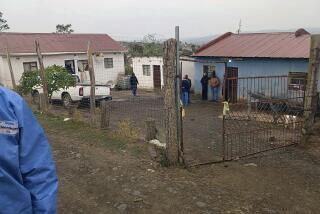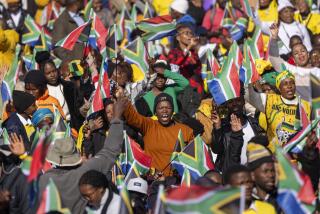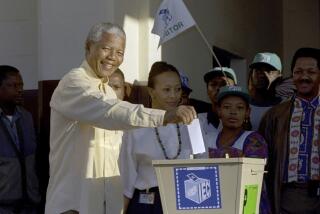Racial Rage Claims 4 More Lives in S. Africa : Violence: Radical black groups take responsibility for attack. Incident shows Cape Town is not immune.
- Share via
CAPE TOWN, South Africa — Welder Roland Palm decided it was time to take his 22-year-old daughter, Rolanda, who had graduated recently from college, out for “a good father-daughter chat” Thursday night at his favorite local pub.
Like the surrounding neighborhood, the Heidelberg bar was filled with mostly white students and young professionals. To avoid the crush, the Palms sat drinking near the door when five black youths walked in shortly before midnight and, without a word, fired a rifle grenade and began shooting from the hip with assault rifles.
“At the first burst, I pulled her down,” said Palm, sobbing as he spoke. “But she just ducked her head. That’s when she got hit.”
When the shooting and screaming stopped, three women, including Rolanda Palm, lay dead inside the bar and a fourth victim lay on the street outside. Five others were wounded. Dozens of bullets had scarred the wooden walls.
Police said the death toll would have been far worse, but the grenade, which the killers had packed with nails, failed to explode.
“If that grenade had gone off, it would have killed us all,” survivor Steve Hamilton said. He said he “hit the deck” when the shooting began, and watched in horror as the three women “jerked like puppets” when they were hit.
The South African Press Assn. reported that men claiming to represent two radical black organizations that violently oppose sharing power with whites--the Azanian People’s Liberation Army and the Azanian National Liberation Army--telephoned separately to claim responsibility for the massacre. Neither claim could be confirmed.
But the latest deadly racial attack did confirm that Cape Town, a seaside resort that prides itself as a bastion of liberal politics and traditions in a country of conservatives, is not immune to the explosive rage that still seethes in South Africa’s black township slums as the nation moves away from apartheid and toward majority rule.
Indeed, this gracious city of colonial buildings, leafy public gardens, busy outdoor cafes and a spectacular setting on the slopes of cloud-shrouded Table Mountain has seen the country’s worst black-on-white violence of the last year. And many fear more is yet to come in the run-up to democratic elections in April.
“It’s clearly political extremists trying to unsettle the people, to terrorize them, to derail everything we have all worked for,” said Ian Iversen, a city councilman.
In April, for example, Cape Town suffered the country’s bloodiest and most destructive race riots after the assassination of popular black leader Chris Hani. Rampaging mobs attacked white passersby, shopkeepers and even white officials of Nelson Mandela’s African National Congress.
In July, several black gunmen armed with assault rifles and hand grenades killed 11 people and wounded more than 50 others in an attack on a multiracial congregation at a suburban church. A 17-year-old youth is due to stand trial for the massacre in February.
Then in August, a chanting crowd of black youths in Guguletu township stabbed and beat to death Amy Biehl, a 26-year-old Fulbright scholar from Newport Beach, Calif., simply because she was white. Her death capped a campaign in which white visitors to the township were openly stoned and attacked.
Like the others, the Heidelberg bar massacre drew quick denunciations from political and religious leaders around the country. Police offered a $60,000 reward for help in arresting the gunmen.
“I’m just very deeply shocked, really shattered, because somehow one was thinking that this kind of carnage was a thing of the past,” Anglican Archbishop Desmond M. Tutu told reporters here.
Black-on-white violence remains the exception in South Africa. More than 4,000 people died in political violence in 1993, and the vast majority were blacks killed by other blacks in mostly anonymous attacks on hostels, homes and trains inside the townships.
In a statement, the ANC noted that most of the deaths go unreported and unremarked.
“It is regrettable that there seems to be a different response when such attacks occur in townships as compared with those that occur where whites are victims,” it said.
Most township violence, the ANC added, is “virtually dismissed as routine.”
Still, Cape Town has seen itself as distinct from the rest of the country. It is the only city to consistently send members of the anti-apartheid white Democratic Party to Parliament, and the only one to boast of its racial tolerance in a country ruled by white supremacists.
But the city’s liberal credentials have always been part illusion. Most whites were sheltered from the brutal reality of apartheid. Back behind Table Mountain, hidden from the crowded beaches and fancy French restaurants, are some of the country’s most impoverished slums--and blacks with some of the most bitter memories of white rule.
This is the only part of the country where blacks are not in the majority. They are outnumbered by people of mixed race, classified as “Colored.” To keep it that way, the white government ruled during the apartheid years that blacks could stay only if they had a job--and the only way to get a job was to prove that both a white and a Colored person had turned it down.
The result was a brutal campaign of forced removals--and fierce resistance. Since most blacks were not supposed to be there, few hospitals, schools or other basic services were built for the more than half a million people who crowded into bleak townships and squatter areas that grew on the city’s outskirts.
Today, the desolate warrens of tin-roofed shacks and garbage-strewn lanes outside Cape Town are home to some of the country’s most militant and marginalized black youths.
The Pan-Africanist Congress, with its notorious anti-white slogan of “One settler, one bullet,” considers the Cape townships a key stronghold. Those accused of Biehl’s murder and the church massacre were members of the PAC or its student wing. And the APLA, one of the two groups claiming responsibility for the Heidelberg bar attack, is the armed wing of the PAC.
Maj. Des Segal, chief police investigator, said those who attacked the church and the bar used similar weapons, ammunition and tactics. “There are obvious similarities,” he said, examining the bullet-riddled bar.
Less clear is why the gunmen would attack Observatory, a fashionable, multiracial suburb that has a history of anti-apartheid activism. Blacks and whites mingle easily on streets lined with elegant Victorian homes, trendy boutiques and art galleries.
“There’s a complete state of shock here,” said Stefanie Hefer, 30, a local resident. “This suburb is so cool. Everyone thought it was the last place for a racial attack.”
Anguished friends and neighbors placed dozens of bouquets of flowers along a curb near the Heidelberg bar Friday, and several hundred area residents gathered for a brief afternoon memorial service on the wind-swept street.
Ebrahim Adams, 27, wept quietly after placing a spray of flowers on the curb. He had survived the attack but was still in a state of shock, he said.
“You come here to have an enjoyment, and you can’t even do that anymore,” he said. “You’re bloody scared to go out tonight. You don’t know what to expect.”
More to Read
Sign up for Essential California
The most important California stories and recommendations in your inbox every morning.
You may occasionally receive promotional content from the Los Angeles Times.











